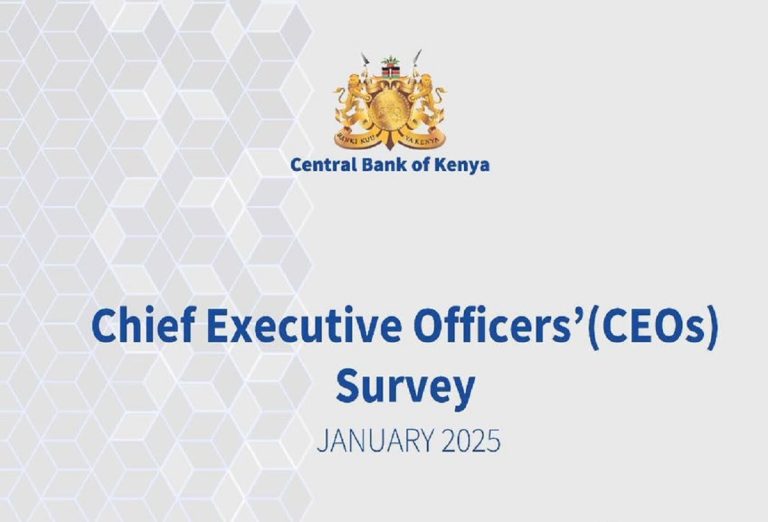Kenyan firms have reported increased optimism regarding economic growth prospects over the next 12 months, driven by expectations of favourable weather conditions and macroeconomic stability, according to the Central Bank of Kenya’s Chief Executive Officers (CEOs) January 2025 report.
The survey highlights improved business confidence in company and sectoral growth prospects, supported by sector-specific strategies and emerging opportunities. Additionally, respondents foresee global economic growth in the next year, underpinned by declining interest rates and low global inflation. However, concerns remain over geopolitical tensions and uncertainty regarding the impact of trade tariffs.
Indicators of business activity improved in the fourth quarter of 2024 compared to the third quarter, partly fuelled by seasonal demand during the festive period. Production volumes and sales are expected to rise in the first quarter of 2025, reflecting optimism over favourable economic conditions.
Key drivers of growth over the next 12 months include customer-centric strategies, talent management, market expansion, and technological innovation. However, the cost of doing business, taxation, and reduced consumer demand remain significant constraints.
The survey assessed CEOs’ optimism regarding the growth prospects of their companies, various sectors, and the broader Kenyan and global economies over the coming year. The findings indicate higher expectations for Kenyan economic growth, primarily attributed to stable macroeconomic conditions—including a steady exchange rate, declining interest rates, and low inflation.
However, business costs remain a pressing concern. Companies are optimistic about growth, supported by strategies such as market and product diversification, operational efficiency improvements, increased marketing efforts, partnerships, and strategic acquisitions. Nonetheless, liquidity constraints (including pending bills and limited access to credit), weak consumer demand, and high operational costs pose challenges to expansion.
Sectoral growth prospects vary. The agriculture sector is expected to benefit from favourable weather conditions and stronger demand for agricultural exports, particularly in the European Union. However, additional levies on farm produce could negatively impact the sector. Limited air freight capacity for agricultural exports also remains a challenge.
The manufacturing sector is projected to perform better, supported by stable energy prices, exchange rate stability, and declining interest rates. However, concerns persist over high operational costs, competition from imports, and subdued consumer demand.
The financial services sector anticipates growth, driven by portfolio diversification, an expanding customer base, and lower interest rates, which are expected to enhance loan repayments and credit flow to the private sector. However, liquidity constraints at both household and business levels remain a concern.
The education sector continues to benefit from rising demand for educational services and the adoption of digital learning. Meanwhile, the Information and Communication Technology (ICT) sector is expected to expand, driven by increased demand and fintech innovations.
In the tourism, hotels, and restaurants sector, growth is largely supported by rising demand for travel. However, respondents cited unfavourable policies, including multiple levies, high taxes, and increased park fees for both local and international tourists, as factors negatively impacting the industry.
Some sectors are experiencing moderated growth prospects. The health sector faces uncertainties due to transitional challenges associated with the new Social Health Insurance Fund, particularly delays in claims payments. Additionally, uncertainty over donor funding—due to policy changes by the new US administration—could affect health programmes.
The wholesale and retail trade, as well as the transport and storage sectors, are likely to be impacted by subdued consumer demand.
Globally, CEOs reported improved growth prospects over the next 12 months, driven by declining interest rates in major economies and low global inflation. However, concerns persist regarding ongoing geopolitical tensions, expected policy shifts by the new US administration, and their potential economic impact.
The survey also examined business activity in the fourth quarter of 2024 relative to the third quarter. More firms reported improved performance in Q4, partly due to seasonal factors. Business confidence indicators reflected higher demand orders, increased production volumes, and stronger sales growth. Purchase and sales prices remained elevated, while business operating costs remained a concern.
Employment levels remained stable, indicating that companies maintained appropriate staffing levels to manage business activities.
During Q4, sales growth was recorded across all three major economic sectors, while demand orders were particularly high in agriculture and manufacturing. The agriculture sector saw increased production volumes, while stability in production was noted in the manufacturing and services sectors, aligning with seasonal trends. Input costs in agriculture rose due to short rains and planting season expenses. Looking ahead to the first quarter of 2025, a larger proportion of CEOs expect improved business prospects compared to Q4 2024, despite ongoing weak consumer demand. Expectations include higher demand orders, production volumes, and sales growth. However, purchase and sales prices are projected to remain elevated, while employment levels are expected to remain largely unchanged





